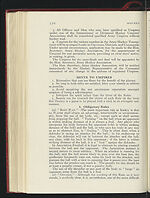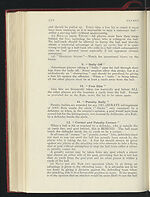1938-39
(357)
Download files
Complete book:
Individual page:
Thumbnail gallery: Grid view | List view

res
es'
ut
a-
s,
of
C,
1
by
s
is
Ife
HOCKEY 331
to administer and the one which calls for the umpire's closest
attention during the whole time that the game is in progress. It
must be borne in mind that a player is " off-side " or not " at the
moment when the ball is hit, or rolled in," and not at the time
when he attempts to play it. The umpire should always keep a
watchful eye on all the forwards of an attacking team, so as to enable
him to know their exact position on the field at the time when the
ball was last HIT or " rolled in " to them or in their direction. A
player will often dash out to follow up a pass, and he may appear
to be badly " off-side " when he reaches the ball, but the question
of his being " off-side " or " on-side " must be decided from his
position on 'the field when the ball was HIT, and not when he reaches
it. Again, the reverse might happen. He might start from an " off-
side " position and appear to be " on-side " when he reaches the
ball ; in this case, as he was " off-side " when the ball was HIT,
he must be penalised when he attempts to play it. An umpire should
be on the alert for either of these contingencies, and correct decisions
on such points can only be given by noting carefully the position of
the players at the time when the ball was HIT. It must be re-
membered that any player of an attacking team, who is behind the
ball at the time when it is passed by one of his own side, is " on-side,"
although there may not be the requisite number of opponents
between him and their goal.
7.
Rules of Advantage
Kicks and handling may be termed " Rules of Advantage,"
which should be penalised when the offender obtains an advantage
by means of the offence. It is quite wrong for an umpire to pull
up a player for kicks or handling when no opponent is near and no
possible advantage is obtained thereby.
A new rule was passed in 1915 whereby the " goalkeeper shall
not be penalised if, in stopping a hit at goal, the ball does not fall
perpendicularly to the ground but merely rebounds off his hand."
The decision whether the ball is " handled " by the goalkeeper in
such a case is left to the discretion of the umpire, but it should be
easy to decide , whether he handled the ball in such a manner so
as to bring himself under the penalty provided by the Rule.
" Knocking-on " the ball with the hand by the goalkeeper is not
allowed.
8. Rules
of Discretion'
(a)
S
TICK
.—An umpire should remember that if a slow-motion
picture weretaken of a hockey match, 90 per cent. of the full strokes
made would show an infringement of the " Sticks " Rule. The
object of the Rule of " Sticks " is to avoid danger. Any hard-
hitting player, who is giving " Sticks " and playing the ball
dangerously, should be pulled up consistently, but a wing-forward
or half-back, who gives mild " Sticks " when no one is near him,
should not necessarily be penalised.
(b)
U
NDERCUTTING.
—The object of the rule is to avoid danger
and, with one exception, the remarks as to " Sticks " apply. 'A
player, by undercutting a free hit, definitely obtains an advantage,
es'
ut
a-
s,
of
C,
1
by
s
is
Ife
HOCKEY 331
to administer and the one which calls for the umpire's closest
attention during the whole time that the game is in progress. It
must be borne in mind that a player is " off-side " or not " at the
moment when the ball is hit, or rolled in," and not at the time
when he attempts to play it. The umpire should always keep a
watchful eye on all the forwards of an attacking team, so as to enable
him to know their exact position on the field at the time when the
ball was last HIT or " rolled in " to them or in their direction. A
player will often dash out to follow up a pass, and he may appear
to be badly " off-side " when he reaches the ball, but the question
of his being " off-side " or " on-side " must be decided from his
position on 'the field when the ball was HIT, and not when he reaches
it. Again, the reverse might happen. He might start from an " off-
side " position and appear to be " on-side " when he reaches the
ball ; in this case, as he was " off-side " when the ball was HIT,
he must be penalised when he attempts to play it. An umpire should
be on the alert for either of these contingencies, and correct decisions
on such points can only be given by noting carefully the position of
the players at the time when the ball was HIT. It must be re-
membered that any player of an attacking team, who is behind the
ball at the time when it is passed by one of his own side, is " on-side,"
although there may not be the requisite number of opponents
between him and their goal.
7.
Rules of Advantage
Kicks and handling may be termed " Rules of Advantage,"
which should be penalised when the offender obtains an advantage
by means of the offence. It is quite wrong for an umpire to pull
up a player for kicks or handling when no opponent is near and no
possible advantage is obtained thereby.
A new rule was passed in 1915 whereby the " goalkeeper shall
not be penalised if, in stopping a hit at goal, the ball does not fall
perpendicularly to the ground but merely rebounds off his hand."
The decision whether the ball is " handled " by the goalkeeper in
such a case is left to the discretion of the umpire, but it should be
easy to decide , whether he handled the ball in such a manner so
as to bring himself under the penalty provided by the Rule.
" Knocking-on " the ball with the hand by the goalkeeper is not
allowed.
8. Rules
of Discretion'
(a)
S
TICK
.—An umpire should remember that if a slow-motion
picture weretaken of a hockey match, 90 per cent. of the full strokes
made would show an infringement of the " Sticks " Rule. The
object of the Rule of " Sticks " is to avoid danger. Any hard-
hitting player, who is giving " Sticks " and playing the ball
dangerously, should be pulled up consistently, but a wing-forward
or half-back, who gives mild " Sticks " when no one is near him,
should not necessarily be penalised.
(b)
U
NDERCUTTING.
—The object of the rule is to avoid danger
and, with one exception, the remarks as to " Sticks " apply. 'A
player, by undercutting a free hit, definitely obtains an advantage,
Set display mode to:
![]() Universal Viewer |
Universal Viewer | ![]() Mirador |
Large image | Transcription
Mirador |
Large image | Transcription
| Games and sports in the army > 1938-39 > (357) |
|---|
| Permanent URL | https://digital.nls.uk/248741247 |
|---|
| Description | 'Games and Sports in the Army' was an annual publication produced by the British War Office between the 1930s and 1960s. This included the Second World War. It outlines the rules and regulations for games and sports played by members of the armed forces. It features names and photographs of team members, and examples of contemporary advertising. |
|---|---|
| Shelfmark | GWB.52 |

